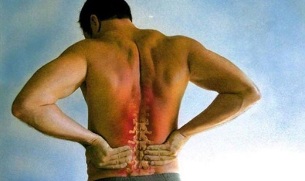
Back pain is the most common complaint made by patients in general medicine. They rank second (after respiratory diseases) in terms of the frequency of requests for medical care. There are many diseases that lead to pain. However, the most common cause is lumbar spine osteochondrosis, the symptoms and treatment of which are covered in this material.
Relatively recently, medicine viewed this condition as age-related changes in the spine associated with the processes of natural aging in the human body.
Lumbar osteochondrosis is now considered to be a fairly serious disease that affects people of all ages. At present, the incidence is steadily decreasing. Increasingly, the disease is diagnosed in people under the age of 30.
Causes of occurrence
The reason for developing lumbar osteochondrosis is not yet known. However, given this pathology, it is often possible to assume that whoever is more prone to the disease is at risk.
Predisposing factors:
- Passive lifestyle. This includes people who lead a predominantly sedentary lifestyle. In a sitting position, the muscles of the corset relax, which increases the load on the lumbar spine.
- Hormonal metabolic disorders and endocrine diseases can affect the metabolism in the tissues of the spine and contribute to the development of osteochondrosis.
- Various congenital and acquired abnormalities in the structure of the musculoskeletal system - curvature of the legs and spine, flat feet.
- The presence of constant heavy physical exertion on the spine, especially when lifting heavy objects. In this case, we can talk about an occupational disease in categories such as weightlifters and people whose professional duties involve constant lifting of heavy objects.
- Constant unhealthy diet and daily routine, regular stress, insufficient sleep time, metabolic disorders.
The points listed above are the most common factors that create the conditions for the development of the disease.
Degree of lumbar osteochondrosis
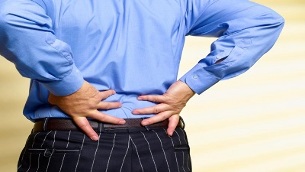
The manifestations of the disease depend on the degree of development of the pathology.
There are four degrees of osteochondrosis:
- Period of change and movement of the nucleus pulposus within the intervertebral disc. Pain occurs due to irritation of the nerve endings in the annulus fibrosus and longitudinal ligaments. The patient feels local discomfort in the part of the spine in which the affected disc is located: acute pain or lumbago in the lower back (lumbago), dull pain of a constant nature (lumbodynia).
- Period of destruction of the annulus fibrosus. It is characterized by the appearance of instability and an increase in the mobility of the vertebrae, which leads to persistent and persistent muscle tension. The patient feels symptoms such as constant fatigue of the muscles of the lower back, discomfort,
- The period of rupture of the annulus fibrosus and the exit of the nucleus pulposus beyond its limits with the formation of a herniated disc. So-called radicular syndromes are observed, which are associated with compression of the nerve roots from fallen fragments.
- The spine is badly deformed. Human motor skills are difficult. The main problem that needs to be addressed is the patient's disability. But it must be emphasized that there is practically no pain at this stage of the disease. However, this is not a signal to suspend the disease, on the contrary.
- There is a pathological proliferation of the bone tissue, which further worsens the condition.
Treatment of osteochondrosis of the lumbar spine is directly related to the degree of the lesion. For this purpose, drug, non-drug and surgical exposure methods are used.
Symptoms of osteochondrosis of the lumbar spine
When osteochondrosis of the lumbar spine occurs, the main symptom is pain. The type of pain sensation, the place of origin and the direction of propagation depend on which receptors are stimulated, i. e. how strong the changes in the intervertebral disc and the surrounding tissues are, whether there is a protrusion or already an inguinal hernia, in which direction the protrusion is formedhas and so on.
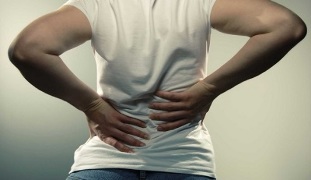
Let's list the main symptoms of lumbar osteochondrosis:
- Pain in the lumbar spine, pain in nature, aggravated by sudden movements, change in body position, prolonged stay in one position. Pain reduction occurs when taking a horizontal position;
- Along with pain in the lumbar spine, osteochondrosis can cause a feeling of weakness in the lower trunk and legs, as well as a loss of tendon reflexes in the lower extremities.
- Curvature of the lumbar spine is common. Depending on where the curvature is observed, we distinguish between scoliosis (curvature of the spine to the right or left), lordosis (forward bending) and kyphosis (smoothing of the lumbar spine);
- If osteochondrosis has resulted in spinal cord clamping and dysfunction, the patient may have uncontrolled urine and stool.
Additional functions:
- Coldness of the skin and numbness in the lumbar region, buttocks;
- dryness, peeling, blue skin on the lower back and buttocks;
- violation of sweating in the buttocks;
- urination disorder;
- erectile dysfunction.
These symptoms indicate the onset of the disease and require medical intervention. Treatment for osteochondrosis can be done in the hospital and at home.
Diagnosis
Various methods are used to diagnose osteochondrosis, most notably palpation of the lumbar spine.
To confirm the diagnosis, the patient is sent to the examination with diagnostic equipment:
- Radiography helps to assess the condition of the spine and each vertebra separately. The integrity of the intervertebral discs and the spinal canal is also assessed indirectly.
- Tomography is used to determine the degree of damage to the nerve endings and the lining of the spinal cord. And also assess the condition of the intervertebral discs.
- MRI - is used to make a definitive diagnosis.
Proper diagnosis helps to understand how lumbar osteochondrosis can be treated and what drugs and procedures are required.
Complications
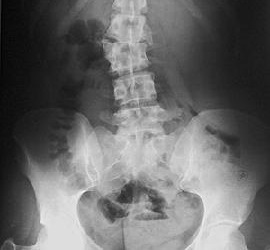
Osteochondrosis of the lumbar spine can lead to protrusions and hernias due to the considerable stress on this spine. It is these complications that develop very quickly, so it is very important to treat them in a timely manner.
In addition, osteochondrosis can be complicated:
- Sciatic nerve inflammation;
- spondyloarthrosis;
- Schmorl's hernia;
- osteophytosis, spondylosis;
- stenosis of the spinal canal with compression and dysfunction of the spinal cord;
- Compression of the cauda equina with dysfunction of the pelvic organs;
- lame;
- Paresis of the lower extremities.
Timely diagnosis and complex treatment can prevent the progression of complications.
Treatment of osteochondrosis of the lumbar spine
If lumbar osteochondrosis is diagnosed, treatment requires extensive complex therapy that includes:
- moderate physical activity;
- use of medicines;
- traction of the spine;
- manual therapy;
- physiotherapy;
- massage.
The treatment regimen for osteochondrosis aims at:
- elimination of the inflammatory process;
- Pain reduction in the lumbosacral area;
- Strengthening the muscles in the lumbar spine, in the buttocks, in the legs;
- Elimination of pathological muscle tension;
- Improvement of the function of the pelvic organs;
- Regulation of blood circulation and metabolic processes in the affected area;
- Restoration of normal range of motion in the lower back and increased sensitivity in the lower extremities.
Surgical interventions are only used in a few cases.
Medicines
Such treatment for osteochondrosis of the lumbar spine includes taking pills, injections and external (ointments and gels) drugs. The drugs used to fight this disease reduce pain and stop inflammation.
Depending on the manifestations, the doctor may prescribe different pills for osteochondrosis in the lower back:
- pain relievers (analgesics);
- nonsteroidal anti-inflammatory drugs;
- muscle relaxants to relieve muscle spasms that occur due to pain;
- chondroprotectors that restore cartilage tissue;
- corticosteroids (prescribed when all other treatments have failed);
- vitamin supplements.
Very often in the treatment of osteochondrosis, pills are prescribed that calm the nervous system, as well as antidepressants that fight stressful situations and depression.
Physiotherapy for lumbar osteochondrosis
Drugs alone are usually not enough to treat osteochondrosis. Physiotherapeutic procedures are used to eliminate pain, relieve muscle spasms, and stimulate metabolic and recovery processes:
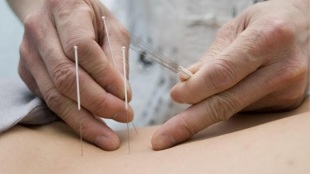
- Amplipuls;
- phonophoresis;
- diadynamic currents;
- darsonvalization;
- magnetic resonance therapy;
- laser therapy.
Massage is prescribed when the main symptom of pain is removed or during remission with chronic pathology. It is used to relax tense muscles. Very often combined with warm-up procedures or a visit to the sauna. This will help increase the relaxing effect on muscle tissue and stimulate blood circulation.
The manual therapy, which is only carried out by a specialist in this field, increases the blood flow to the spinal cord and replaces the dislocated intervertebral discs of the spine.
Remedial gymnastics
The full range of physical exercises for diagnosing lumbar osteochondrosis should help improve the mobility of the lumbar spine.
Remedial gymnastics is not effective if the exercises are done from time to time. The main principle of exercise therapy is regularity. Constantly performing a certain set of exercises will help get rid of destructive processes in the intervertebral joints.
surgery
Usually, a doctor will only operate if serious complications arise. For example, an intervertebral hernia. The most common type of surgery is to remove the damaged disc (discectomy).
This operation is considered the most productive method in this case. But at the same time, it is prescribed only if other methods of treatment do not give results within six months. In addition, the procedure of microsurgical and endoscopic treatment of the spine is widely used.



























